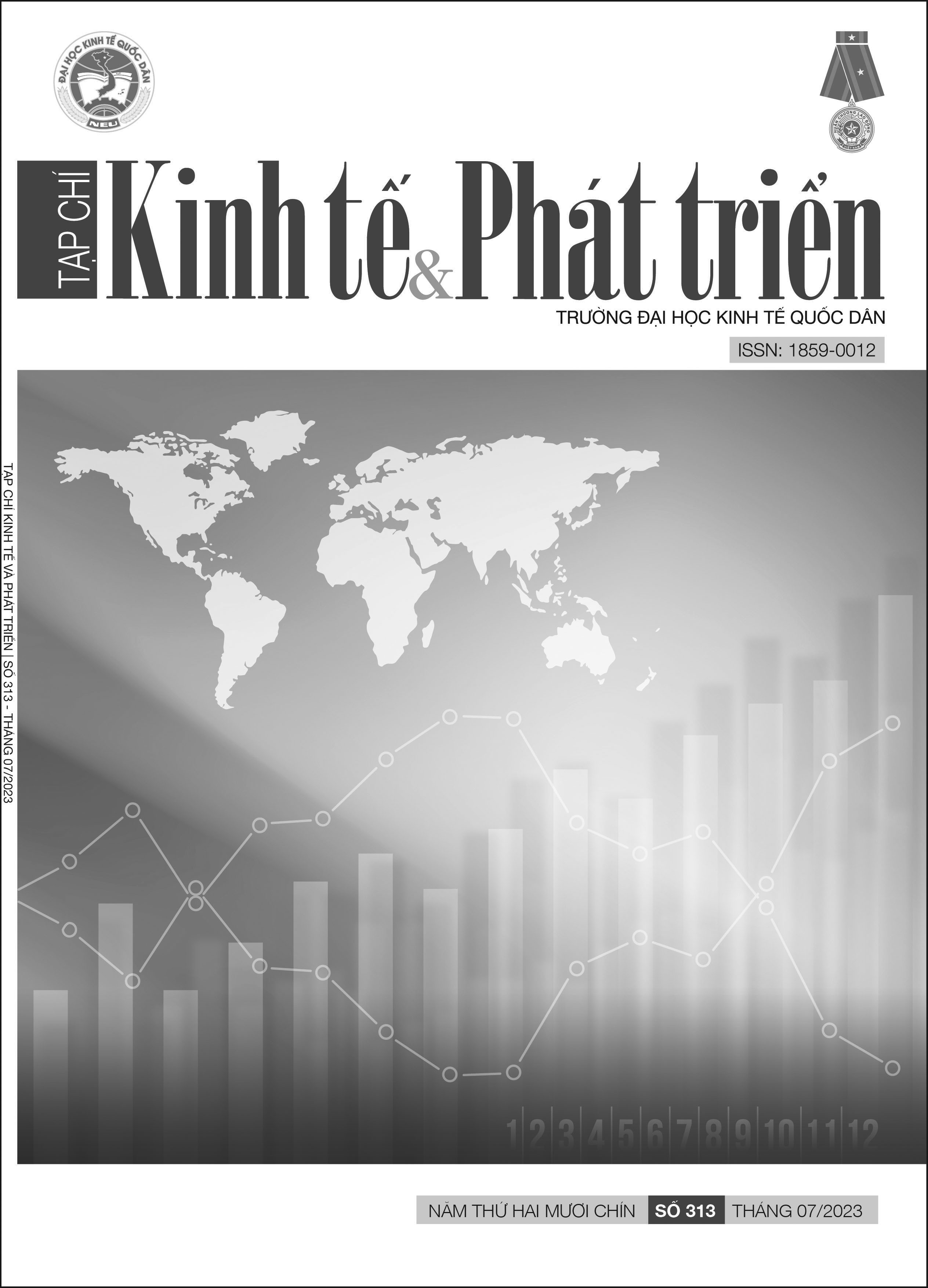Vai trò của nhà đầu tư tổ chức đối với hiệu ứng đảo ngược dồn tích: bằng chứng trên thị trường chứng khoán Việt Nam
DOI:
https://doi.org/10.33301/JED.VI.1068Từ khóa:
Lợi nhuận doanh nghiệp, phần dồn tích, phần dòng tiền, tỷ suất sinh lợi vượt trộiTóm tắt
Nghiên cứu này kiểm định tác động của nhà đầu tư tổ chức đến mối quan hệ giữa tỷ suất sinh lợi bất thường và các thành phần của lợi nhuận (dồn tích và dòng tiền) trên thị trường chứng khoán Việt Nam. Theo đó, nhà đầu tư tổ chức sẽ tăng tốc quá trình phản ánh thông tin hàm chứa trong các thành phần của lợi nhuận vào giá cổ phiếu. Bên cạnh đó, nghiên cứu còn chỉ ra tác động khác nhau giữa phần dồn tích và phần dòng tiền đến lợi nhuận trong tương lai. Tuy nhiên, nhà đầu tư lại không nhận biết được sự khác biệt này và không phản ánh đầy đủ và nhanh chóng hàm ý thông tin vào giá cổ phiếu. Kết quả nghiên cứu cho thấy chiến lược đầu tư mua cổ phiếu công ty có thành phần dồn tích thấp và bán cổ phiếu công ty có thành phần dồn tích cao tạo ra tỷ suất sinh lợi vượt trội 5,4% mỗi năm.
Tài liệu tham khảo
Ali, A., Chen X., Yao T. & Yu T. (2008), ‘Do Mutual Funds Profit from the Accruals Anomaly?’, Journal of Accounting Research, 46(1), 1-26.
Ball, R. & Brown, P. (1968), ‘An Empirical of Accounting Income Numbers’, Journal of Accounting Research, 6(2), 159-178.
Bartov, E., Radhakrishnan, S., & Krinsky, I. (2000). ‘Investor sophistication and patterns in stock returns after earnings announcements’, Accounting Review, 75(1), 43–63.
Bernstein, L. (1993), Financial Statement Analysis: Theory, Application and Interpretation, 5th Edition, Irwin, USA.
Cai, G., Lin, B., Wei M. & Xu, X. (2021), ‘The role of institutional investors in post-earnings announcement drift: evidence from China’, Accounting and Business Research, 51(2), 206-236.
Collins, D., Gong, G. & Hribar, P. (2003), ‘Investor Sophistication and the Mispricing of Accruals’, Review of Accounting Studies, 8, 251-276.
Dechow, P. & Dichev, I. (2002), ‘The quality of accruals and earnings: The role of accrual estimation errors’, The Accounting Review, 77, 35-59.
Easton, P. & Harris, T. (1991), ‘Earning as Explanatory Variable for Returns’, Journal of Accounting Research, 29, 19-36.
Fama, E. & French, K. (1993), ‘Common Risk Factors in the Returns on Stocks and Bonds’, Journal of Financial Economics, 33, 3-56.
Foerster, S., Tsagarelis J. & Wang, G. (2017), ‘Are Cash Flows Better Stock Return Predictors than Profits?’, Financial Analysts Journal, 73(1), 73-99.
Foster, G., Olsen, C. & Shevlin, T. (1984), ‘Earnings releases, anomalies, and the behavior of security returns’, The Accounting Review, 59(4), 574-603.
Francesco, G. & Rakesh, G. (2013), ‘Market Efficiency in the ASEAN Region: Evidence from Multivariate and Cointegration Tests’, Applied Financial Economics, 23(4), 265-274.
Freeman, R., Ohlson, J. & Penman, S. (1982), ‘Book Rate-of-Return and Prediction of Earnings Changes: An Empirical Investigation’, Journal of Accounting Research, 20(2), 639-653.
Graham B., Dodd, D. & Cottle, S. (1962), Security Analysis: Principles and Techniques, 4th Edition, McGraw-Hill Book Co., New York, USA.
Hirshleifer D., Hou, K. & Teoh, S.H. (2012), ‘The Accrual Anomaly: Risk or Mispricing?’, Management Science, 58(2), 320-335.
Hirshleifer, D., Teoh, S.H. & Yu, J.J. (2011), ‘Short Arbitrage, Return Asymmetry, and the Accrual Anomaly’, Review of Financial Studies, 24(7), 2429-2461.
International Accounting Standards Board (IASB) (2018), Conceptual Framework for Financial Reporting, IFRS Foundation, USA.
Ke, B. & Ramalingegowda, S. (2005). ‘Do institutional investors exploit the post-earnings announcement drift?’, Journal of Accounting and Economics, 39(1), 25–53.
Kothari, S.P. (2001), ‘Capital markets research in accounting’, Journal of Accounting and Economics, 31(1-3), 105-231.
Lewellen, J. (2010), ‘Accounting anomalies and fundamental analysis: An alternative view’, Journal of Accounting and Economics, 50(2-3), 455-466.
Maines, L. & Hand, J. (1996), ‘‘Individuals’ Perceptions and Misperceptions of Time Series Properties of Quarterly Earnings’, The Accounting Review, 71(3), 317-336.
Mashruwala, C., Rajgopal, S. & Shevlin, T. (2006), ‘Why is the accrual anomaly not arbitraged away? The role of idiosyncratic risk and transaction costs’, Journal of Accounting and Economics, 42(1), 3-33.
Mishkin, F. (1983), A Rational Expectations Approach to Macroeconometrics: Testing Policy Effectiveness and Efficient Markets Models, University of Chicago Press.
Ou, J. & Penman, S. (1989), ‘Financial Statement Analysis and the Prediction of Stock Returns’, Journal of Accounting and Economics, 11(4), 295-329.
Pincus, M., Rajgopal, S. & Venkatachalam, M. (2007), ‘The Accrual Anomaly: International Evidence’, The Accounting Review, 82(1), 169-203.
Richardson, S., Sloan, R., Soliman, M. & Tuna, I. (2005), ‘Accrual Reliability, Earnings Persistence and Stock Prices’, Journal of Accounting and Economics, 39(3), 437-485.
Richardson, S., Tuna, İ. & Wysocki, P. (2010), ‘Accounting anomalies and fundamental analysis: A review of recent research advances’, Journal of Accounting and Economics, 50(2-3), 410-454.
Shi, L. & Zhang, H. (2012), ‘Can the Earnings Fixation Hypothesis Explain the Accrual Anomaly?’, Review of Accounting Studies, 17(1), 1-21.
Sloan, R. (1996), ‘Do Stock Prices Fully Reflect Information in Accruals and Cash Flows about Future Earnings?’, The Accounting Review, 71(3), 289-315.
Truong, D.L., Lanjouw, G. & Lensink, R. (2010), ‘Stock-Market Efficiency in Thin-Trading Markets: The Case of the Vietnamese Stock Market’, Applied Economics, 42(27), 3519-3532.
Walther, B. (1997), ‘Investor Sophistication and Market Earnings Expectations’, Journal of Accounting Research, 35(2), 157-179.
Zhang, F. (2007), ‘Accruals, investment, and the accrual anomaly’, The Accounting Review, 82(5), 1333-1363.





